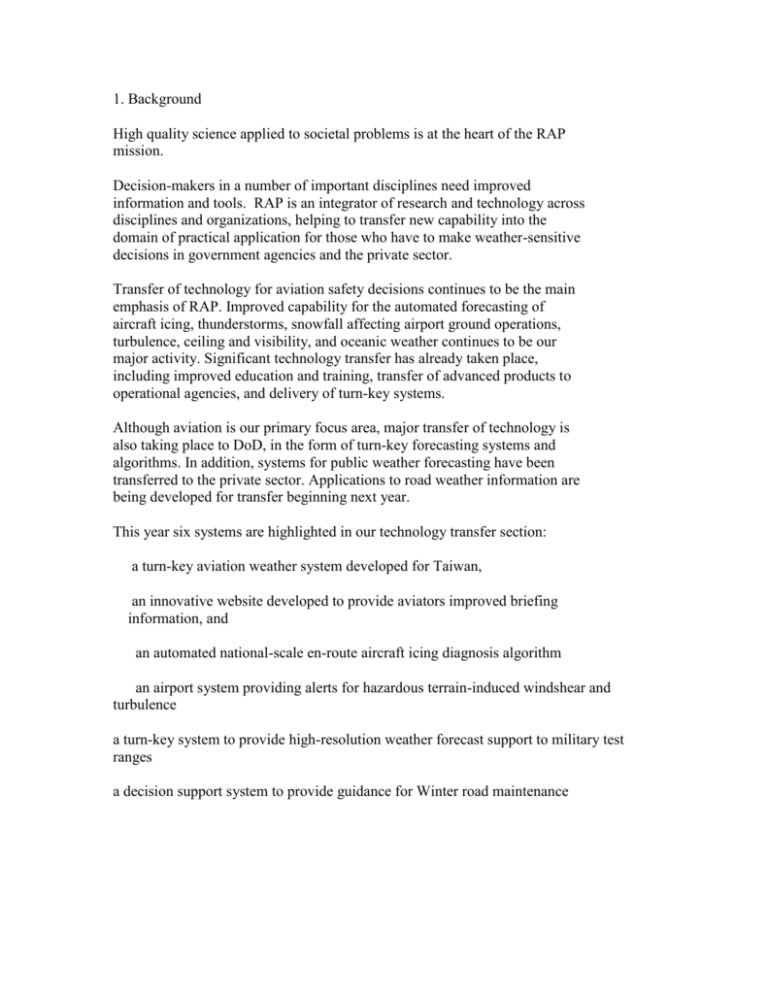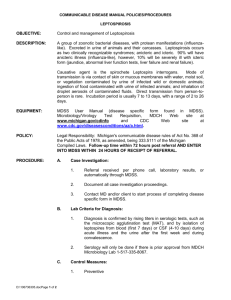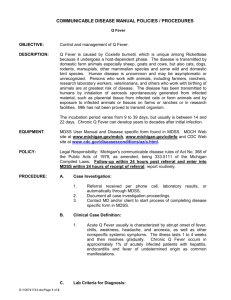ASR
advertisement

1. Background High quality science applied to societal problems is at the heart of the RAP mission. Decision-makers in a number of important disciplines need improved information and tools. RAP is an integrator of research and technology across disciplines and organizations, helping to transfer new capability into the domain of practical application for those who have to make weather-sensitive decisions in government agencies and the private sector. Transfer of technology for aviation safety decisions continues to be the main emphasis of RAP. Improved capability for the automated forecasting of aircraft icing, thunderstorms, snowfall affecting airport ground operations, turbulence, ceiling and visibility, and oceanic weather continues to be our major activity. Significant technology transfer has already taken place, including improved education and training, transfer of advanced products to operational agencies, and delivery of turn-key systems. Although aviation is our primary focus area, major transfer of technology is also taking place to DoD, in the form of turn-key forecasting systems and algorithms. In addition, systems for public weather forecasting have been transferred to the private sector. Applications to road weather information are being developed for transfer beginning next year. This year six systems are highlighted in our technology transfer section: a turn-key aviation weather system developed for Taiwan, an innovative website developed to provide aviators improved briefing information, and an automated national-scale en-route aircraft icing diagnosis algorithm an airport system providing alerts for hazardous terrain-induced windshear and turbulence a turn-key system to provide high-resolution weather forecast support to military test ranges a decision support system to provide guidance for Winter road maintenance Taiwan – Advanced Operational Aviation Weather System (AOAWS) The Advanced Operational Aviation Weather System (AOAWS) is a 6-year aviation weather system modernization program (1997-2003), sponsored by the Taiwan Civil Aeronautics Administration. The Civil Aeronautics Administration (CAA) commissioned NCAR to design, build and implement the AOAWS in Taiwan as a technology transfer program between the U.S. Government and Taiwan. NCAR/RAP is leading the program and other participants include NCAR/MMM, and the Institute for Information Industry, a local Taiwan not-for-profit information technology organization. In FY2002, the AOAWS System successfully completed its final Site and Reliability Acceptance Tests. The System is now operational and being used by the aviation community in Taiwan and by airlines that fly into Taiwan. Although NCAR will provide support and maintenance services through 200, the system is being operated on a daily basis by the Taiwan CAA. The AOAWS consists of advanced meteorological sensor systems (at airports and within the Taiwan airspace), a communications infrastructure, a product generation component, a system server component that distributes products to users, and several product displays that present the advanced aviation weather information to end users. AOAWS system components are fully integrated to form an operational, turnkey system that serves the aviation community flying within or through Taiwan airspace. The AOAWS will provide the CAA, the airlines and the flying public with state-of-theart aviation weather technology for: 1) hazardous weather phenomena that affect aviation operations (e.g., in-flight icing, clear air turbulence, windshear, and thunderstorms), 2) weather phenomena that affect airspace capacity and safety at the major hub airports, and 3) weather phenomena that affect overall efficiency of aviation operations. The AOAWS is a complex system utilizing several advanced weather sensing subsystems, integrated communications, advanced software developed by NCAR/RAP, advanced numerical weather forecast models developed by NCAR/MMM, and NCAR/RAP developed advanced interactive and web based display technology. System displays are located at the Taipei Aeronautical Meteorological Center, several Weather Forecast Stations and Flight Information Service facilities at Taiwan airports, and at the Taipei Area Control Center. This technology transfer project was completed on schedule and within budget. The CAA has expressed strong interest in a second phase program that will be designed to ensure the CAA continues to have a state-of-the-art aviation weather capability. FY02 technology transfer accomplishments in 4DWX program Since 1995, a team of RAP engineers and scientists have been developing and implementing a Four-Dimensional Weather (4DWX) system for the U.S. Army Test and Evaluation Command (ATEC), and recently, for the Defense Threat Reduction Agency (DTRA). As the system consists of late-breaking engineering technologies, and scientific advancements in numerical weather prediction – and furthermore must operate reliably in live, mission-critical situations – RAP has been faced with a substantial technology transfer challenge, which includes the regular training of DoD staff at seven locations around the U.S. on systems that are frequently updated. The 4DWX system provides the ATEC meteorology groups with their primary source of weather data, forecasts and analyses. Forecasting decisions are routinely based on the 4DWX tools that provide high-resolution, range-specific information and forecasts of low-level winds, expected dispersion patterns of bio-chemical simulant agents, noise propagation patterns from high-explosives detonation, pinpoint thunderstorm cell locations, and model-derived climatological information. In addition, capabilities to quickly provide worldwide weather information and model runs are available for support of international missions. The system consist of a suite of modeling, algorithmic and data handling capabilities designed to provide advanced meteorological analysis, forecast and display capabilities for meteorological units at Army test ranges and proving grounds throughout the United States. System modules include 1) a data management, ingest, archival, and display system; 2) a product distribution system employing the WWW: 3) high-resolution (1.1 km) MM5 modeling capabilities; and 4) fuzzy-logic techniques for short-term thunderstorm forecasting. To date, 4DWX systems have been fielded at seven ATEC ranges around the country, and are continuously monitored and improved by the 4DWX development team. This unique system represents a union between the research and operational communities, allowing state-of-the-art techniques to quickly be transferred from the laboratory to operational use. Within the last year, 4DWX systems have been transferred to another branch of the Army to support live operations in Afghanistan, and to DTRA, in support of live exercises to mitigate the effect of weapons of mass destruction (WMD) for the 2002 Salt Lake City Olympics. Figure 1 shows the general 4DWX system architecture, in terms of the product flows. One of the substantial challenges in technology transfer has been in creating and deploying stable linux clusters for running the high-resolution numerical weather prediction (NWP) component of the systems. While traditional, single-image, shared memory platforms like SGI’s and Fujitsu’s are very suitable for NWP applications, especially for their stability aspects, the 4DWX clients require a number of platforms to be deployed, but the hardware budget does not allow for the purchase of these mainframe class machines. As a result of this, RAP has had to develop the forecast systems on distributed memory, parallel processing clusters, running the Linux operating system, and using commodity hardware components. The challenge to produce stable platforms is particularly acute in that the 4DWX NWP systems run continuously around the clock, and are usually located in remote facilities where the power source tends to be unstable and generally unreliable. Figure 1: 4DWX Weather Product Flows Figure 2 shows examples of the front and back views of these clusters, which tend to be configured as either 16- or 32-node systems for each of the test ranges. Figure 2: Front view of systems located at NCAR Foothills Lab, and back view of systems located at NCAR Mesa Lab As part of the technology transfer work for these clusters, RAP has had to incorporate advanced power monitoring and fault-tolerant software into each cluster system, as the range test schedules have become more demanding and critical since September 11, 2001. RAP continues to have challenges here, and is in the process of reviewing all aspects of system reliability, including developing more extensive training material for range forecasters and technicians. In FY03, it is anticipated that live system monitoring and alert notifications will be made available to wireless hand held devices, allowing range personnel to react more quickly when problems arise. While test range forecasters have a great deal of experience in interpreting the local meteorology, few have much experience and understanding in the realm of highresolution mesoscale modeling, i.e., understanding the limitations of the model in various regimes, and distinguishing the atmospheric signal of highly resolved processes from noise. An ongoing challenge in transferring 4DWX technology to the ranges has been to impart sufficiently high levels of interpretive skills to the forecasters, so that they may better utilize the model forecast output information. RAP’s ongoing mesoscale forecasting training to the ranges has substantially improved the forecaster’s effectiveness in providing test guidance to their own clients. In FY02, new training modules were created to stimulate new ideas on how to interpret the model output. The test range meteorology chiefs are currently considering ways of incorporating such training in the forecaster’s annual reviews, so as to make the study of mesoscale forecasts integral to their annual performance. An example of a training module can be found at: http://www.mmm.ucar.edu/individual/davis/atec/training.html Winter Road Maintenance Decision Support System (MDSS) In FY2000, the Federal Highway Administration (FHWA) Road Weather Management Program began a project to develop a prototype winter road Maintenance Decision Support System (MDSS). The MDSS is designed to provide guidance on winter maintenance decisions (treatment times, types, rates, and locations) specific to winter road maintenance routes. Five national research centers have participated in the development of the functional prototype MDSS. The participating national labs include the Army’s Cold Regions Research and Engineering Laboratory (CRREL), National Science Foundation’s National Center for Atmospheric Research (NCAR), Massachusetts Institute of Technology - Lincoln Laboratory (MIT/LL), National Oceanic and Atmospheric Administration (NOAA) National Severe Storms Laboratory (NSSL), and NOAA Forecast Systems Laboratory (FSL). NCAR’s Research Application Program (RAP) is the lead lab for technical development and program coordination. The requirements gathering phase of the MDSS project began in fiscal year 2000. In 2001 the goal was to develop a conceptual prototype MDSS and in FY2002 a functional prototype was developed. An MDSS field demonstration and verification project will occur during the winter months of 2003 in Iowa for plow routes near Des Moines and Ames. System refinements will be made based on the results of the field demonstration and they will become part of the second system release. The MDSS project goal is to develop a prototype capability that capitalizes on existing road and weather data sources, fuses data to make an open, integrated and understandable presentation of current environmental and road conditions, processes data to generate diagnostic and prognostic maps of road conditions, provides a display capability on the state of the roadway, provides a decision support tool which provides recommendations on road maintenance courses of action together with anticipated consequences of action or inaction. Technology transfer is a major component of the MDSS Project. The MDSS functional prototype software (version-1) was developed between October 2001 and September 2002. The overarching goal of the MDSS project is to accelerate the time to market for MDSS capabilities; therefore the MDSS and its components were made available to the public on a non-exclusive basis on 20 September 2002. Interested parties can register to obtain a CD with documentation and code via a web site at NCAR/RAP. Another objective of the MDSS project is to create a surface transportation weather capability in the national labs and with surface transportation stakeholders. The stakeholders who are public-sector transportation operators and privatesector weather information service providers will be the beneficiaries of applying that capability. The MDSS FP is designed to be a template for future operational capabilities. It is envisioned that the private sector together with local DOTs will review the FP and jointly develop operational versions of the system whether standalone or integrated with broader decision support systems.






